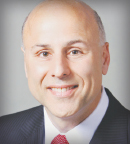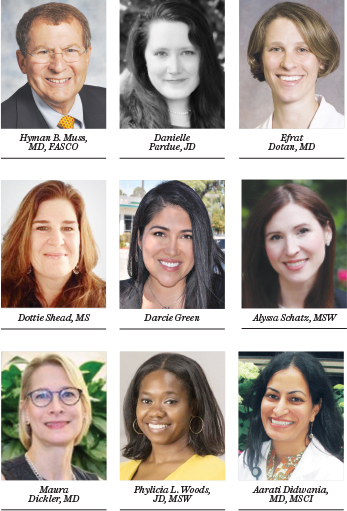
Jan White
The keynote speaker did not mince words. “I tell everyone, do not use the term age-appropriate therapy,” said Jan White, a cancer survivor and patient advocate who described her own experience with stage IV non-Hodgkin lymphoma. “Patients with cancer,” she said, “are more than their age, gender, or disease.”
Her message, stressing the need to avoid assumptions based on age and other patient characteristics, remained a lively and multifaceted theme throughout the afternoon. Speakers and panelists at the National Comprehensive Cancer Network® (NCCN®) Virtual Patient Advocacy Summit, held virtually on December 10, 2020, discussed how and why patient needs and preferences may vary and how policies and practices based on understanding those variations may optimize care.

Clifford Goodman, PhD
Discussions, moderated by Clifford Goodman, PhD, Senior Vice President at The Lewin Group, touched on the needs related to age, sociocultural factors, and health-care policies and practices that impact cancer care.
Age-Specific Needs
Older adults, who make up a majority of people with cancer, face a variety of age-related issues in addition to their disease, said panelist Hyman B. Muss, MD, FASCO, whose practice focuses on older patients with cancer at the University of North Carolina Lineberger Comprehensive Cancer Center, Chapel Hill.
Treating older patients means addressing issues such as function, cognitive status, nutrition, and social and caregiver support—“all things we frequently miss if we focus only on the cancer,” said Dr. Muss. Especially useful for geriatric assessments, he said, are the Cancer and Aging Research Group’s Geriatric Assessment Tool and the NCCN Clinical Practice Guidelines in Oncology (NCCN Guidelines®) for Older Adult Oncology. Both are available online at no cost (see “Resources” at right).
It is also important, Dr. Muss observed, to elicit the patient’s own views. “I usually ask my patients to tell me about themselves,” he said. That request can lead to a fruitful discussion about goals for treatment including issues such as curative vs palliative care. Asking patients for a “personal statement” in writing has also proved helpful, Dr. Muss said, and is now being considered for inclusion as a regular part of his practice.
Including a patient’s caregiver in the discussion, whether a family member or other supportive individual, is another way to learn more about needs and preferences, said Danielle Pardue, JD, a caregiver and patient advocate. Accepting and valuing caregivers as part of the conversation, she observed, not only lead to greater understanding of patient needs, but also help a provider take both the patient’s preferences and the caregiver’s abilities into account when determining treatment recommendations. “Without caregiver buy-in,” she said, “treatment plans will fail, especially at home.”
“One of the things most patients want to know is how therapies can affect their lives,” noted panelist Efrat Dotan, MD, of Fox Chase Cancer Center, who chairs the NCCN Guidelines Panel for Older Adult Oncology. “As we refine our understanding of tumor biology and tailor therapy to the molecular subtype of each tumor, we must remember factors outside of the actual treatment that significantly affect outcomes,” she said. “Especially when treating older adults with cancer, evaluating all the domains that affect their care—and addressing any deficiencies—will result in truly personalized medicine and improved outcomes.”
Cancer survivors who were first diagnosed during childhood or adolescence face unique concerns. Panelists discussed the confusion that can arise over what happens after patients have completed active treatment. Survivorship care plans and clinical practice guidelines can help, they said, noting that the NCCN Guidelines for Survivorship address symptom management and age-related care for adolescents and young adults.
In addition, patient and caregiver guidelines focused specifically on survivorship will soon be added to the library of NCCN Guidelines for Patients, said Dottie Shead, MS, of NCCN’s patient information department. (These guidelines were posted on the NCCN website in late December. See “Resources.”)
Social and Cultural Issues
Throughout the meeting, speakers and panelists noted that age-specific needs and preferences often intersect with social and cultural factors, such as race, gender, sexual orientation, income, education, and more.
“We cannot separate social, racial, and economic inequality from the adult cancer journey,” said panelist Darcie Green, Executive Director of Latinas Contra Cancer, which provides services to the underserved Latinx population around issues of cancer. One of its goals is “to make patients aware that they are part of the picture, part of a collaboration,” she said.
It is crucial to understand cultural issues because they have a great impact on a patient’s response to diagnosis and therapy, Ms. Green said. “If you don’t have some insight into cultural issues, you are missing an opportunity to build trust, to be effective.”
Among the sociocultural issues patients often face are “predictable and preventable systemic barriers to cancer care,” she said, barriers that include the cost of care. “Navigating cancer can be challenging enough without also having to worry about how you will feed your family, pay rent, absorb income loss, or overcome the obstacles that exist within the health-care system.”
Policy and Practice Solutions
The effects of sociocultural issues on cancer care were also explored in a final panel discussion on policies and practices. A key question, posed by Dr. Goodman, was which issue needs attention now: “Where do we need to go next with the issues of ageism, racism, and gender bias?”
They are all important, answered Alyssa Schatz, MSW, Senior Director of Policy and Advocacy for NCCN. However, racism is one of her main concerns, she said, including the importance of ensuring that it does not influence appropriate use of clinical guidelines.
Maura Dickler, MD, Vice President of Late Phase Development for Lilly Oncology, answered that racial disparities are also an issue when it comes to clinical trials. Although trials provide new treatment options for many patients, the lack of racial diversity in trials limits their use for many others.
“At Lilly, we are committed to reducing the barriers that limit diversity in clinical trial enrollment,” she said. Specific measures include “working to ensure our trial sites are closer to patients, utilizing new forms of telehealth when appropriate, and broadening eligibility criteria so we are not excluding patients who have additional health conditions.”

Legislation currently before Congress could also make it easier for some patients to participate in trials, noted Phylicia L. Woods, JD, MSW, of the Cancer Support Community, which focuses on patient advocacy. The proposed Clinical Treatment Act, she said, would expand access to clinical trials for patients on Medicaid, the only major payer that doesn’t guarantee coverage of routine care costs for trial participants. The Clinical Treatment Act was included in the year-end appropriations package.
With regard to the “isms,” Ms. Woods said, “we need to learn what socioeconomic policies and realities affect cancer risk. How do education, geographic location, and housing affect health care? We need to look broader,” she said.
Aarati Didwania, MD, MSCI, of the Robert H. Lurie Comprehensive Cancer Center of Northwestern University, agreed, noting that all the “isms” mentioned could be considered in terms of social determinants of health that introduce barriers to care. “We need to address these barriers,” she said, and it is really important for us to recognize what these things are. I think we’ve taken that first step.”
DISCLOSURES: For disclosure information and more on the NCCN COVID-19 Vaccine Committee, visit NCCN.org.
Resources
Cancer and Aging Research Group’s Geriatric Assessment Tool:
NCCN Guidelines for Older Adult Oncology:
www.nccn.org/professionals/physician_gls/pdf/senior.pdf
NCCN Guidelines for Patients: Survivorship Care for Healthy Living:
https://www.nccn.org/professionals/physician_gls/pdf/survivorship.pdf

